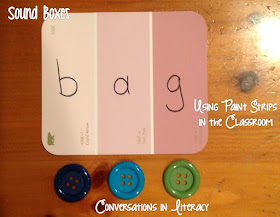Short vowel, cvc, words are an important foundation to build for students. Students who struggle are often the ones who have not gotten a good handle on their short vowel sounds or are unable to switch vowel sounds from long to short or short to long. We use a lot of different activities to build that base for students, hopefully strengthening those sounds. I like to do activities with hands on activities. Some of these use paint strips!
Paint strips just make nifty little sound boxes. Colorful buttons, pom poms, Bingo chips, etc... are great for sliding into the boxes to hear the sounds. Just ask for the paint strips. The store clerks are always so nice when I ask if I could have a few for my class!
I like to laminate some of the paint strips so students can write on them. Then we keep them in our guided reading material baskets. Not only do we use them to stretch words out for word work, the students use them when they are writing in response to their reading. Some of them need the scaffolding of the boxes to help them stretch and hear the sounds as they write.
An easy word work activity with almost no prepping is to use the paint strips and cvc picture cards. Students choose a card, stretch out the word and write the letters in the boxes. I like to have vowel charts sitting on the table to help them remember what sound each vowel makes.
This activity is super easy and the kids love to work at puzzles! They put the puzzles together- great way for them to physically place the vowel in the middle for cvc words. Then they can write the words underneath. My students need that extra step of writing the words after building them. An important step is to take the puzzles away and have the students read the cvc words without the picture clues.
Super simple- use your cvc picture cards again, but this time have students build the words with magnetic letters. Remove the cards again and have students read the words to each other.
One of my students' favorite activities is rolling cubes! I use them in a lot of different ways. I always have them record the words and then I want them to read the words.
So far, we have gone through activities to take students from hearing individual sounds and attaching those sounds to the correct letters to reading and saying individual sounds. But we want to move students from individual sounds into chunking the sounds together. For some struggling readers this is a hard step to recognize chunks.
One great activity that we do a LOT of is word sorting. We start out with me guiding them to what ways we could sort the words, but I like to get to the point where students have the words and must figure out what ways they could be sorted. Much higher level thinking to do the blind sort!
I like to use a lot of charts in binders in my room for students to read. Some students just need that extra, daily practice to become automatic and fluent with short vowel sounds. Again, I want them to see and read in chunks.

Having the boxes, scoops, and arrows as visuals are helpful to students.
I don't want my students to only work with individual words. Reading connected text is important. We work hard to build that fluency in sentences. Students need to be able to read smoothly and accurately.
Building on that connected text, students should be able to read small paragraphs. But I stress to my students that reading fluently is so we can understand what we are reading. After all, that is what reading is all about- understanding the text!













Love these ideas! I am switching from being a 5/6 interventionist to a K-4 interventionist....and these activites are perfect! Thanks for the ideas!
ReplyDeleteKatie
Mind Sparks
Thank you so much, Katie! Hope you like your new position as K-4 interventionist!
DeleteLaminated paint chips! Great idea - just like elkonin boxes.
ReplyDeleteThe paint chips are great to work with, Tammy!
Delete